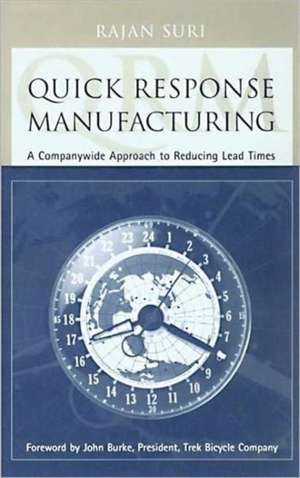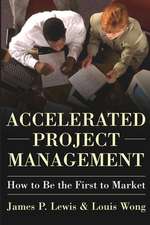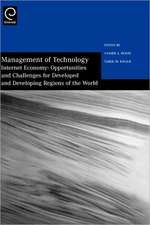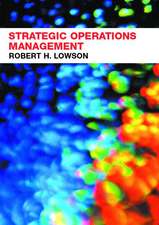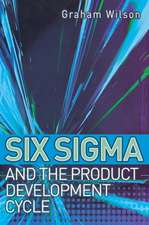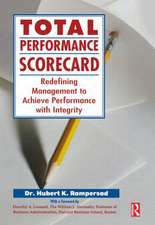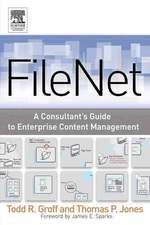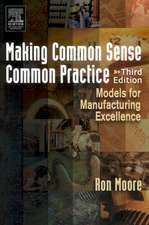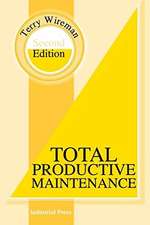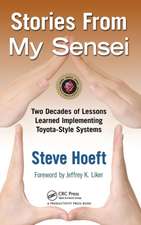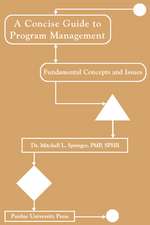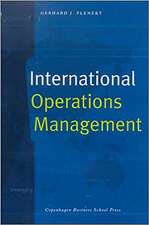Quick Response Manufacturing: A Companywide Approach to Reducing Lead Times
Autor Rajan Surien Limba Engleză Hardback – 22 iun 1998
Preț: 451.67 lei
Preț vechi: 490.95 lei
-8% Nou
Puncte Express: 678
Preț estimativ în valută:
86.44€ • 93.86$ • 72.61£
86.44€ • 93.86$ • 72.61£
Carte disponibilă
Livrare economică 01-15 aprilie
Livrare express 15-21 martie pentru 51.39 lei
Preluare comenzi: 021 569.72.76
Specificații
ISBN-13: 9781563272011
ISBN-10: 1563272016
Pagini: 574
Ilustrații: figs.tabs.
Dimensiuni: 152 x 229 x 36 mm
Greutate: 1.03 kg
Ediția:1
Editura: Taylor & Francis
Colecția Productivity Press
Locul publicării:Oxford, United Kingdom
ISBN-10: 1563272016
Pagini: 574
Ilustrații: figs.tabs.
Dimensiuni: 152 x 229 x 36 mm
Greutate: 1.03 kg
Ediția:1
Editura: Taylor & Francis
Colecția Productivity Press
Locul publicării:Oxford, United Kingdom
Public țintă
Professional and Professional Practice & DevelopmentNotă biografică
Rajan Suri (Founding Director, Center for Quick Response Manufacturing, Madison, Wisconsin, USA) (Author)
Recenzii
"Rajan Suri's principles of Quick Response Manufacturing are easy to grasp and powerfully effective. They allowed us to reduce elapsed manufacturing time from 23 days to 7 days and work-in-process by 41 percent."
— Charles J. Monante, President, Converter Concepts, Inc., JUNE 2004
"Dr. Rajan Suri explains Quick Response Manufacturing (QRM) in easy to understand terms: why it is necessary, its benefits, and how to implement it. At John Deere, we are using the QRM philosophy and tools to train our employees and our supply base. QRM has enabled us to implement changes that improve customer response time and take millions of dollars out of our supply chain."
— Bill Butterfield, Supplier Development Process Owner, Deere and Company, JUNE 2004
— Charles J. Monante, President, Converter Concepts, Inc., JUNE 2004
"Dr. Rajan Suri explains Quick Response Manufacturing (QRM) in easy to understand terms: why it is necessary, its benefits, and how to implement it. At John Deere, we are using the QRM philosophy and tools to train our employees and our supply base. QRM has enabled us to implement changes that improve customer response time and take millions of dollars out of our supply chain."
— Bill Butterfield, Supplier Development Process Owner, Deere and Company, JUNE 2004
Cuprins
PART ONE: A New Way of Thinking Stems from One Principle Chapter One: QRM: Not Just Another Buzzword Chapter Two: Benefits of QRM Chapter Three: The Response Time Spiral -- Legacy of the Scale and Cost Management Strategies PART TWO: Rethinking Production and Materials Management Chapter Four: Reorganizing Production Chapter Five: Structured Methodology for Implementing Cellular Manufacturing Chapter Six: Creative Rethinking for Cellular Manufacturing Chapter Seven: Capacity and Lot-Sizing Decisions Chapter Eight: Material and Production Planning in the QRM Enterprise Chapter Nine: POLCA -- The New Material Control and Replenishment System for QRM Chapter Ten: Customer and Supplier Relations PART THREE: Rethinking Office Operations Chapter Eleven: Principles of Quick Response for Office Operations Chapter Twelve: Tools to Support Q-ROC Implementation Chapter Thirteen: System Dynamics Principles for Quick Response PART FOUR: QRM for Rapid New Product Introduction Chapter Fourteen: Extending Quick Response to New Product Introduction PART FIVE: Creating the QRM Enterprise Chapter Fifteen: Management Mind-Set to Support QRM Chapter Sixteen: Organizational Structure, Performance Measurement, and Cost Systems Chapter Seventeen: Steps to Successful Implementation of a QRM Program Appendix Endnotes About the Author Index
Descriere
Developed by the author and now being employed by a number of businesses, Quick Response Manufacturing (QRM) is an expansion of time-based competition, aimed at a single target with the goal of reducing lead times. The key difference between QRM and other time-based programs is that QRM covers an entire organization, from the shop floor to the office, to sales and beyond. Providing guidelines for establishing a QRM enterprise, this volume builds upon kaizen, TQM, TPM, and other practice to help organizations streamline all functions of their operation. It shows how to quickly introduce products, along with ways to rethink materials and production management.
